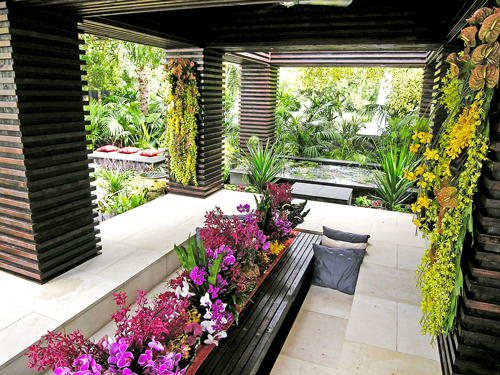Jim Fogarty says as indoor and outdoor spaces merge, building structures outdoors has become a key part of modern garden design.
Gardens have become so much more than just garden beds, a few trees and a lawn. In our great climate, people want to spend more of their downtime outdoors. There is a yearning to connect with nature. Houses are getting bigger, and with the inside-outside look so popular now, architecture is creeping outside and becoming an important part of how we design our gardens.
Old traditions
The idea of bringing architecture into gardens is nothing new. Architectural features and follies were popular in historic gardens of Europe, whether it was the Italianate Grottoes or the English Summerhouses of centuries past. Older European gardens often included very large and shaded pavilions to provide shelter from rain or the sun. Garden parties became popular in the Victorian era and the need for permanent garden pavilions increased as a result. Some gardens were large enough to accommodate guesthouses and other family residences.
Pergolas & arbours
In Australia’s brief history of garden design the inclusion of pergolas, arbours and sheds are familiar structures, as are retaining walls and steps to provide changes in levels, but the structural design of our gardens remained quite simple for many years.
It is only in recent years with the onset of modern architecture that there has been a slow shift away from these basic forms of garden structures to new designs offering a lifestyle based on comfortable outdoor living.
Outdoor rooms
The concept of outdoor living replaced the courtyard look and where once we might have sat under a pergola, we’re now relaxing in outdoor rooms where we entertain friends. These are designated areas designed and built with a specific lifestyle in mind. Functionality and aesthetics are combined in a useful, pleasing looking place.
Even more recent trends in garden have now gone well beyond the outdoor room. We are now seeing outdoor showers, baths, kitchens, living rooms, fireplaces and even bedrooms and daybeds.
Gardens are moving indoors and houses are moving outdoors. Whether you live in the cooler parts of Australia and value your summers outdoors or you live in the tropics and want to spend cooler evenings outside the house, new designs are using structures to make this dream lifestyle possible.
Streamlining
The great American architect Frank Lloyd-Wright introduced the concept of ‘streamlining’ in the early 1900s. Streamlining was the idea of taking sharp angles and corners out of designs and making shapes more rounded, giving a softer, modern looking appearance to any building. If you look at some modern architecture around today you will notice strong influences of streamlining in shapes used by architects and designers. Streamlining can be used in the horizontal or vertical plane and takes on the same concept as that used in engineering or airline design.
Modular housing
Modular housing is a technique used by architects where new houses can be massed-produced on the same specifications, which reduces overall costs. Modular (or kit) homes have become popular not only as domestic homes, but also for holiday houses, granny flats and home offices. With this trend has come the ‘pod’ concept, which is the idea of using small, modern built structures as drop-in outdoor rooms, or home offices sitting in a back garden.
New materials
The range of materials available and the colour schemes used are what make this new form of garden architecture so exciting. Natural materials are popular such as exposed Australian timbers, along with rusted steel (corten) and zinc cladding. Steel comes in various forms including perforated or laser-cut steel and has opened up many possibilities with finishes of built structures. Inspiration tends to come from the juxtaposition of modern forms against natural elements.
Styling touches
The finish of a garden ties in the style, texture and colour of built elements with the plants used in a garden. Furniture now comes in many forms and shapes and there is no end to the materials used for creating effects.
Shapes are important with modern furniture and designers are looking for options outside the ubiquitous rectangular dining table and chairs. Fabrics now come in many colour and pattern options and can be extremely effective in unifying a garden’s colour palette.
Styling can be overdone, but with the right effect is an important part of dressing garden architecture so that it blends into your landscape.



